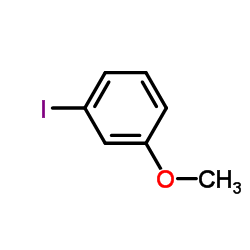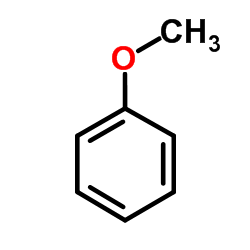BIS(ACETATO-O)(3-METHOXYPHENYL)IODINE
Modify Date: 2024-01-08 11:49:26

BIS(ACETATO-O)(3-METHOXYPHENYL)IODINE structure
|
Common Name | BIS(ACETATO-O)(3-METHOXYPHENYL)IODINE | ||
|---|---|---|---|---|
| CAS Number | 69180-50-3 | Molecular Weight | 352.12200 | |
| Density | N/A | Boiling Point | N/A | |
| Molecular Formula | C11H13IO5 | Melting Point | 134-138ºC | |
| MSDS | N/A | Flash Point | N/A | |
| Name | [acetyloxy-(3-methoxyphenyl)-λ3-iodanyl] acetate |
|---|---|
| Synonym | More Synonyms |
| Melting Point | 134-138ºC |
|---|---|
| Molecular Formula | C11H13IO5 |
| Molecular Weight | 352.12200 |
| Exact Mass | 351.98100 |
| PSA | 61.83000 |
| LogP | 2.32740 |
Synonym:None Section 2 - COMPOSITION, INFORMATION ON INGREDIENTS
Risk Phrases: None Listed. Section 3 - HAZARDS IDENTIFICATION EMERGENCY OVERVIEW
The toxicological properties of this material have not been fully investigated. Potential Health Effects Eye: May cause eye irritation. Skin: May cause skin irritation. Ingestion: The toxicological properties of this substance have not been fully investigated. Inhalation: The toxicological properties of this substance have not been fully investigated. Chronic: No information found. Section 4 - FIRST AID MEASURES Eyes: Immediately flush eyes with plenty of water for at least 15 minutes, occasionally lifting the upper and lower eyelids. Get medical aid immediately. Skin: Get medical aid. Flush skin with plenty of water for at least 15 minutes while removing contaminated clothing and shoes. Ingestion: Do NOT induce vomiting. If conscious and alert, rinse mouth and drink 2-4 cupfuls of milk or water. Inhalation: Remove from exposure and move to fresh air immediately. If not breathing, give artificial respiration. If breathing is difficult, give oxygen. Get medical aid. Notes to Physician: Section 5 - FIRE FIGHTING MEASURES General Information: As in any fire, wear a self-contained breathing apparatus in pressure-demand, MSHA/NIOSH (approved or equivalent), and full protective gear. During a fire, irritating and highly toxic gases may be generated by thermal decomposition or combustion. Extinguishing Media: In case of fire, use water, dry chemical, chemical foam, or alcohol-resistant foam. Section 6 - ACCIDENTAL RELEASE MEASURES General Information: Use proper personal protective equipment as indicated in Section 8. Spills/Leaks: Clean up spills immediately, observing precautions in the Protective Equipment section. Sweep up, then place into a suitable container for disposal. Section 7 - HANDLING and STORAGE Handling: Wash thoroughly after handling. Remove contaminated clothing and wash before reuse. Avoid contact with eyes, skin, and clothing. Avoid ingestion and inhalation. Handle under an inert atmosphere. Storage: Store in a cool, dry place. Keep container closed when not in use. Section 8 - EXPOSURE CONTROLS, PERSONAL PROTECTION Engineering Controls: Use adequate general or local exhaust ventilation to keep airborne concentrations below the permissible exposure limits. Exposure Limits CAS# 69180-50-3: Personal Protective Equipment Eyes: Wear appropriate protective eyeglasses or chemical safety goggles as described by OSHA's eye and face protection regulations in 29 CFR 1910.133 or European Standard EN166. Skin: Wear appropriate protective gloves and clothing to prevent skin exposure. Clothing: Wear appropriate protective clothing to minimize contact with skin. Respirators: Follow the OSHA respirator regulations found in 29 CFR 1910.134 or European Standard EN 149. Use a NIOSH/MSHA or European Standard EN 149 approved respirator if exposure limits are exceeded or if irritation or other symptoms are experienced. Section 9 - PHYSICAL AND CHEMICAL PROPERTIES Physical State: Solid Color: Not available. Odor: none reported pH: Not available. Vapor Pressure: Not available. Viscosity: Not available. Boiling Point: Not available. Freezing/Melting Point: 136 deg C Autoignition Temperature: Not available. Flash Point: Not available. Explosion Limits, lower: Not available. Explosion Limits, upper: Not available. Decomposition Temperature: >135 deg C Solubility in water: slightly soluble Specific Gravity/Density: Molecular Formula: C11H13IO5 Molecular Weight: 352.13 Section 10 - STABILITY AND REACTIVITY Chemical Stability: Stable under normal temperatures and pressures. Conditions to Avoid: Incompatible materials. Incompatibilities with Other Materials: Strong oxidizing agents. Hazardous Decomposition Products: Irritating and toxic fumes and gases. Hazardous Polymerization: Has not been reported. Section 11 - TOXICOLOGICAL INFORMATION RTECS#: CAS# 69180-50-3 unlisted. LD50/LC50: Not available. Carcinogenicity: Bis(acetato-O)(3-methoxyphenyl)iodine - Not listed by ACGIH, IARC, or NTP. Section 12 - ECOLOGICAL INFORMATION Section 13 - DISPOSAL CONSIDERATIONS Dispose of in a manner consistent with federal, state, and local regulations. Section 14 - TRANSPORT INFORMATION IATA Not regulated as a hazardous material. IMO Not regulated as a hazardous material. RID/ADR Not regulated as a hazardous material. Section 15 - REGULATORY INFORMATION European/International Regulations European Labeling in Accordance with EC Directives Hazard Symbols: Not available. Risk Phrases: Safety Phrases: S 24/25 Avoid contact with skin and eyes. WGK (Water Danger/Protection) CAS# 69180-50-3: No information available. Canada None of the chemicals in this product are listed on the DSL/NDSL list. CAS# 69180-50-3 is not listed on Canada's Ingredient Disclosure List. US FEDERAL TSCA CAS# 69180-50-3 is not listed on the TSCA inventory. It is for research and development use only. SECTION 16 - ADDITIONAL INFORMATION N/A |
| Safety Phrases | 24/25 |
|---|
|
~74% 
BIS(ACETATO-O)(... CAS#:69180-50-3 |
| Literature: Zielinska, Agnieszka; Skulski, Lech Molecules, 2002 , vol. 7, # 11 p. 806 - 809 |
|
~16% 
BIS(ACETATO-O)(... CAS#:69180-50-3 |
| Literature: Chun, Joong-Hyun; Lu, Shuiyu; Pike, Victor W. European Journal of Organic Chemistry, 2011 , # 23 p. 4439 - 4447 |
|
~95% 
BIS(ACETATO-O)(... CAS#:69180-50-3 |
| Literature: Hossain, Md. Delwar; Kitamura, Tsugio Journal of Organic Chemistry, 2005 , vol. 70, # 17 p. 6984 - 6986 |
|
~% 
BIS(ACETATO-O)(... CAS#:69180-50-3 |
| Literature: Shah, A.; Widdowson, D. A.; Pike, V. W. Journal of Labelled Compounds and Radiopharmaceuticals, 1997 , vol. 40, p. 65 - 67 |
|
~% 
BIS(ACETATO-O)(... CAS#:69180-50-3 |
| Literature: White; Caravatti; Kline; et al. Tetrahedron, 1983 , vol. 39, # 14 p. 2393 - 2397 |
| 3-methoxyphenyliodine diacetate |
| MFCD00143760 |
| 3-methoxyiodobenzene diacetate |
| HMS1439P16 |
| 3-Methoxy-phenyliodosoacetat |




